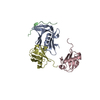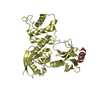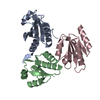+ Open data
Open data
- Basic information
Basic information
| Entry | Database: PDB / ID: 6uyi | ||||||
|---|---|---|---|---|---|---|---|
| Title | hRpn13:hRpn2:K48-diubiquitin | ||||||
 Components Components |
| ||||||
 Keywords Keywords | PROTEIN BINDING / ubiquitin receptor | ||||||
| Function / homology |  Function and homology information Function and homology informationproteasome accessory complex / proteasome regulatory particle / proteasome regulatory particle, lid subcomplex / proteasome regulatory particle, base subcomplex / symbiont entry into host cell via disruption of host cell glycocalyx / Regulation of ornithine decarboxylase (ODC) / Proteasome assembly / Cross-presentation of soluble exogenous antigens (endosomes) / Somitogenesis / molecular function inhibitor activity ...proteasome accessory complex / proteasome regulatory particle / proteasome regulatory particle, lid subcomplex / proteasome regulatory particle, base subcomplex / symbiont entry into host cell via disruption of host cell glycocalyx / Regulation of ornithine decarboxylase (ODC) / Proteasome assembly / Cross-presentation of soluble exogenous antigens (endosomes) / Somitogenesis / molecular function inhibitor activity / symbiont entry into host cell via disruption of host cell envelope / virus tail / proteasome binding / regulation of protein catabolic process / proteasome storage granule / endopeptidase activator activity / proteasome assembly / enzyme regulator activity / Regulation of activated PAK-2p34 by proteasome mediated degradation / Autodegradation of Cdh1 by Cdh1:APC/C / APC/C:Cdc20 mediated degradation of Securin / Asymmetric localization of PCP proteins / Ubiquitin-dependent degradation of Cyclin D / proteasome complex / NIK-->noncanonical NF-kB signaling / SCF-beta-TrCP mediated degradation of Emi1 / TNFR2 non-canonical NF-kB pathway / AUF1 (hnRNP D0) binds and destabilizes mRNA / Vpu mediated degradation of CD4 / Assembly of the pre-replicative complex / Ubiquitin-Mediated Degradation of Phosphorylated Cdc25A / Degradation of DVL / Dectin-1 mediated noncanonical NF-kB signaling / Cdc20:Phospho-APC/C mediated degradation of Cyclin A / Degradation of AXIN / Hh mutants are degraded by ERAD / Activation of NF-kappaB in B cells / Degradation of GLI1 by the proteasome / Hedgehog ligand biogenesis / G2/M Checkpoints / Defective CFTR causes cystic fibrosis / GSK3B and BTRC:CUL1-mediated-degradation of NFE2L2 / Autodegradation of the E3 ubiquitin ligase COP1 / Negative regulation of NOTCH4 signaling / Regulation of RUNX3 expression and activity / Vif-mediated degradation of APOBEC3G / Hedgehog 'on' state / Degradation of GLI2 by the proteasome / GLI3 is processed to GLI3R by the proteasome / FBXL7 down-regulates AURKA during mitotic entry and in early mitosis / APC/C:Cdh1 mediated degradation of Cdc20 and other APC/C:Cdh1 targeted proteins in late mitosis/early G1 / MAPK6/MAPK4 signaling / Degradation of beta-catenin by the destruction complex / transcription elongation by RNA polymerase II / Oxygen-dependent proline hydroxylation of Hypoxia-inducible Factor Alpha / ABC-family proteins mediated transport / CDK-mediated phosphorylation and removal of Cdc6 / CLEC7A (Dectin-1) signaling / SCF(Skp2)-mediated degradation of p27/p21 / Regulation of expression of SLITs and ROBOs / FCERI mediated NF-kB activation / Regulation of PTEN stability and activity / Interleukin-1 signaling / Orc1 removal from chromatin / Regulation of RAS by GAPs / Regulation of RUNX2 expression and activity / The role of GTSE1 in G2/M progression after G2 checkpoint / Separation of Sister Chromatids / KEAP1-NFE2L2 pathway / UCH proteinases / Downstream TCR signaling / Antigen processing: Ubiquitination & Proteasome degradation / azurophil granule lumen / Neddylation / RUNX1 regulates transcription of genes involved in differentiation of HSCs / ER-Phagosome pathway / protease binding / proteasome-mediated ubiquitin-dependent protein catabolic process / Ub-specific processing proteases / ubiquitin protein ligase binding / Neutrophil degranulation / extracellular region / nucleoplasm / nucleus / membrane / plasma membrane / cytosol Similarity search - Function | ||||||
| Biological species |  Homo sapiens (human) Homo sapiens (human) | ||||||
| Method | SOLUTION NMR / simulated annealing | ||||||
 Authors Authors | Lu, X. / Walters, K.J. | ||||||
| Funding support |  United States, 1items United States, 1items
| ||||||
 Citation Citation |  Journal: Structure / Year: 2020 Journal: Structure / Year: 2020Title: An Extended Conformation for K48 Ubiquitin Chains Revealed by the hRpn2:Rpn13:K48-Diubiquitin Structure. Authors: Lu, X. / Ebelle, D.L. / Matsuo, H. / Walters, K.J. | ||||||
| History |
|
- Structure visualization
Structure visualization
| Structure viewer | Molecule:  Molmil Molmil Jmol/JSmol Jmol/JSmol |
|---|
- Downloads & links
Downloads & links
- Download
Download
| PDBx/mmCIF format |  6uyi.cif.gz 6uyi.cif.gz | 1.3 MB | Display |  PDBx/mmCIF format PDBx/mmCIF format |
|---|---|---|---|---|
| PDB format |  pdb6uyi.ent.gz pdb6uyi.ent.gz | 1.1 MB | Display |  PDB format PDB format |
| PDBx/mmJSON format |  6uyi.json.gz 6uyi.json.gz | Tree view |  PDBx/mmJSON format PDBx/mmJSON format | |
| Others |  Other downloads Other downloads |
-Validation report
| Summary document |  6uyi_validation.pdf.gz 6uyi_validation.pdf.gz | 440.2 KB | Display |  wwPDB validaton report wwPDB validaton report |
|---|---|---|---|---|
| Full document |  6uyi_full_validation.pdf.gz 6uyi_full_validation.pdf.gz | 778.7 KB | Display | |
| Data in XML |  6uyi_validation.xml.gz 6uyi_validation.xml.gz | 81.9 KB | Display | |
| Data in CIF |  6uyi_validation.cif.gz 6uyi_validation.cif.gz | 108.1 KB | Display | |
| Arichive directory |  https://data.pdbj.org/pub/pdb/validation_reports/uy/6uyi https://data.pdbj.org/pub/pdb/validation_reports/uy/6uyi ftp://data.pdbj.org/pub/pdb/validation_reports/uy/6uyi ftp://data.pdbj.org/pub/pdb/validation_reports/uy/6uyi | HTTPS FTP |
-Related structure data
- Links
Links
- Assembly
Assembly
| Deposited unit | 
| |||||||||
|---|---|---|---|---|---|---|---|---|---|---|
| 1 |
| |||||||||
| NMR ensembles |
|
- Components
Components
| #1: Protein | Mass: 8691.918 Da / Num. of mol.: 1 Source method: isolated from a genetically manipulated source Source: (gene. exp.)  Homo sapiens (human) / Gene: UBB / Production host: Homo sapiens (human) / Gene: UBB / Production host:  |
|---|---|
| #2: Protein | Mass: 8604.845 Da / Num. of mol.: 1 Source method: isolated from a genetically manipulated source Source: (gene. exp.)  Homo sapiens (human) / Gene: UBB / Production host: Homo sapiens (human) / Gene: UBB / Production host:  |
| #3: Protein | Mass: 17040.340 Da / Num. of mol.: 1 Source method: isolated from a genetically manipulated source Source: (gene. exp.)  Homo sapiens (human) / Gene: ADRM1, GP110 / Production host: Homo sapiens (human) / Gene: ADRM1, GP110 / Production host:  |
| #4: Protein/peptide | Mass: 2003.036 Da / Num. of mol.: 1 Source method: isolated from a genetically manipulated source Source: (gene. exp.)  Homo sapiens (human) / Gene: PSMD1 / Production host: Homo sapiens (human) / Gene: PSMD1 / Production host:  |
| Has protein modification | Y |
-Experimental details
-Experiment
| Experiment | Method: SOLUTION NMR | ||||||||||||||||||||||||||||||
|---|---|---|---|---|---|---|---|---|---|---|---|---|---|---|---|---|---|---|---|---|---|---|---|---|---|---|---|---|---|---|---|
| NMR experiment |
|
- Sample preparation
Sample preparation
| Details |
| ||||||||||||||||||||||||||||||||||||
|---|---|---|---|---|---|---|---|---|---|---|---|---|---|---|---|---|---|---|---|---|---|---|---|---|---|---|---|---|---|---|---|---|---|---|---|---|---|
| Sample |
| ||||||||||||||||||||||||||||||||||||
| Sample conditions | Ionic strength: 0.11 M / Label: conditions_1 / pH: 6.5 / Pressure: ambient atm / Temperature: 298.15 K |
-NMR measurement
| NMR spectrometer |
|
|---|
- Processing
Processing
| Software | Name:  X-PLOR / Version: NIH / Classification: refinement X-PLOR / Version: NIH / Classification: refinement | ||||||||||||||||||
|---|---|---|---|---|---|---|---|---|---|---|---|---|---|---|---|---|---|---|---|
| NMR software |
| ||||||||||||||||||
| Refinement | Method: simulated annealing / Software ordinal: 1 | ||||||||||||||||||
| NMR representative | Selection criteria: fewest violations | ||||||||||||||||||
| NMR ensemble | Conformer selection criteria: structures with the least restraint violations Conformers calculated total number: 100 / Conformers submitted total number: 15 |
 Movie
Movie Controller
Controller












 PDBj
PDBj



